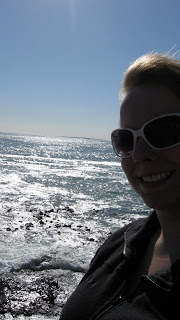

Below are some pictures from around Stellenbosch. The city is about 60,000 residents during the school year (20,000 otherwise), so it's a pretty small city. The majority of the people speak Afrikaans, and a lot of the signs are only in Afrikaans. I have learned how to say "please" and "thank you" in Afrikaans and hope to learn to count to 10 before I leave South Africa. This region is well known acros the world for its vineyards. I think I may go on a tour of a vineyard and wine cellar before I leave here on Monday. The architecture here is very colonial - it reminds me of New England. Almost all the buildings are white, some have thatched roofs, and many were built before 1800. It almost seems like a theme park. I wonder if they have codes regarding historical preservation - like if it's a requirement that even new buildings look "historical." Something I will have to find out.

A park near my hostel. There are mountains here, too! :)

Tourist information office - thatched roof.

I think this was a seminary of some sort, but I'm not sure because the sign was only in Afrikaans.

One of the few building of color in the town.

A street near the University of Stellenbosch campus. I think this is primarily student housing.

The University's sports complex. I wish the Gophers got to play sports on a backdrop like this one.


I had to be the typical tourist taking pictures of wildflowers on the UStell campus. :)


Pedestrian/bike bridge and trail near campus.

The trees along their main street are wrapped in red fabric - I assume that's for their wine festival taking place this weekend.

A church - of which denomination, I'm not sure. I could only really photograph its steeple because the lower part of the building was blocked by a huge wall.

Even the more modern buildings here have a distinct look to them. Historical preservation code in place?
In other news, my friend Tim sent me this link. He had seen the story on BBC - "Zeros will be knocked off the Zimbabwe dollar, making 10bn dollars one dollar" on Friday. Funny, because this hyperinflation has been going on for awhile now, and I just recently mentioned it and suggested "knocking some zeros off" on here.










































